Evaluation of taVNS for extreme environments: an exploration study of health benefits and stress operationality
Le Roy, B., Martin-Krumm, C., Gille, A., Jacob, S., Vigier, C., Laborde, S., Claverie, D., Besnard, S., & Trousselard, M.
Contact : barbara.m.le.roy@gmail.com
Abstract of this article published 11/22/2023 in Frontiers in Neurology

Research on transcutaneous vagus nerve stimulation (taVNS) is rapidly expanding, and its modalities pose a major research challenge. An increasing number of reviews emphasize the need to validate biomarkers to monitor effects and improve our understanding of the mechanisms through which taVNS operates. Heart rate variability (HRV) appears to be a relevant candidate that informs about the autonomic nervous system (ANS). It is a promising technique to minimize the pathogenic effects of such large-scale missions and could therefore constitute a relevant countermeasure. This study aimed to investigate the impact of taVNS on cognitive, psychological, and physiological functioning, including ANS functioning, as well as the benefits of increasing the number of taVNS sessions.
Method A total of 44 healthy participants were randomly assigned to one of two crossover protocols: a single-session protocol (one taVNS and one sham stimulation) or a repeated-session protocol (three taVNS and three sham stimulations). Cognitive (executive and attentional, assessed with MindPulse), psychological, and physiological measures were taken before (pre) and after (post) each intervention. Sleep monitoring was only recorded before the first and after the last intervention of each protocol. For the repeated-session protocol only, participants were divided into two groups based on their parasympathetic activation gain during the three interventions: high parasympathetic delta (HPd) and low parasympathetic delta (LPd).
"Long-duration space missions pose a real challenge for maintaining astronauts' adaptability."
Results : Participants in the repeated-session protocol showed increased HRV, cognitive performance, and sleep efficiency. Specifically, taVNS induced higher parasympathetic activation and cardiac flexibility compared to sham stimulation in the repeated-session protocol. However, stress perception may indicate a nocebo effect of repeated sessions. The HPd profile exhibited better interoceptive awareness, HRV highlighted by nonlinear measures, and improved cognitive performance, but a decrease in some sleep efficiency indicators compared to the LPd profile.
Conclusion : Transcutaneous vagus nerve stimulation (taVNS) appears to induce positive health outcomes, especially when the stimulation is repeated three times per week. Our findings highlight the benefits of parasympathetic activation during taVNS on psychophysiological and cognitive functioning. Further research is needed to validate these results on a large sample size, using longitudinal measures over several months. This intervention appears promising as a countermeasure to extreme missions and occupations.
Transcutaneous vagus nerve stimulation (taVNS) is a non-invasive method that uses low electrical stimulation applied to the surface of the skin, typically at the ear, to modulate the activity of the vagus nerve. This nerve plays a crucial role in regulating various physiological processes, but it is also involved in mood regulation, stress, and cognition. taVNS is being studied in psychology as a promising approach to improving mood, cognition, and alleviating certain psychological symptoms, although further research is needed to fully understand its effectiveness.
